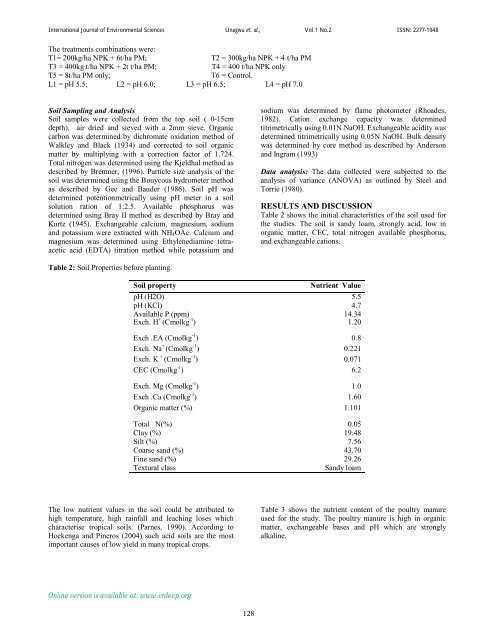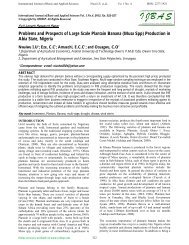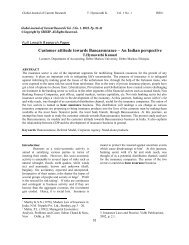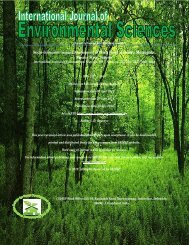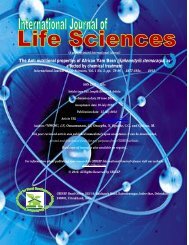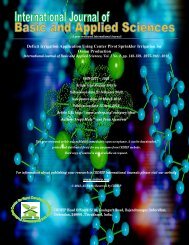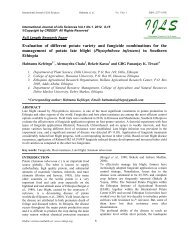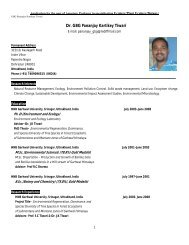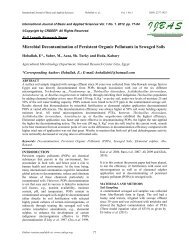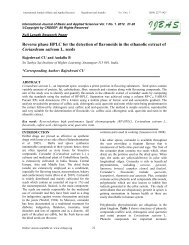Download Pdf - CRDEEP
Download Pdf - CRDEEP
Download Pdf - CRDEEP
Create successful ePaper yourself
Turn your PDF publications into a flip-book with our unique Google optimized e-Paper software.
International Journal of Environmental Sciences Unagwu et. al., Vol.1 No.2 ISSN: 2277-1948<br />
The treatments combinations were:<br />
T1= 200kg/ha NPK + 6t/ha PM; T2 = 300kg/ha NPK + 4 t/ha PM<br />
T3 = 400kg t/ha NPK + 2t t/ha PM;<br />
T4 = 400 t/ha NPK only<br />
T5 = 8t/ha PM only;<br />
T6 = Control.<br />
L1 = pH 5.5; L2 = pH 6.0; L3 = pH 6.5; L4 = pH 7.0<br />
Soil Sampling and Analysis<br />
Soil samples were collected from the top soil ( 0-15cm<br />
depth), air dried and sieved with a 2mm sieve. Organic<br />
carbon was determined by dichromate oxidation method of<br />
Walkley and Black (1934) and corrected to soil organic<br />
matter by multiplying with a correction factor of 1.724.<br />
Total nitrogen was determined using the Kjeldhal method as<br />
described by Bremner, (1996). Particle size analysis of the<br />
soil was determined using the Bouycous hydrometer method<br />
as described by Gee and Bauder (1986). Soil pH was<br />
determined potentionmetrically using pH meter in a soil<br />
solution ration of 1:2.5. Available phosphorus was<br />
determined using Bray II method as described by Bray and<br />
Kurtz (1945). Exchangeable calcium, magnesium, sodium<br />
and potassium were extracted with NH 4 OAc. Calcium and<br />
magnesium was determined using Ethylenediamine tetraacetic<br />
acid (EDTA) titration method while potassium and<br />
sodium was determined by flame photometer (Rhoades,<br />
1982). Cation exchange capacity was determined<br />
titrimetrically using 0.01N NaOH. Exchangeable acidity was<br />
determined titrimetrically using 0.05N NaOH. Bulk density<br />
was determined by core method as described by Anderson<br />
and Ingram (1993)<br />
Data analysis: The data collected were subjected to the<br />
analysis of variance (ANOVA) as outlined by Steel and<br />
Torrie (1980).<br />
RESULTS AND DISCUSSION<br />
Table 2 shows the initial characteristics of the soil used for<br />
the studies. The soil is sandy loam, strongly acid, low in<br />
organic matter, CEC, total nitrogen available phosphorus,<br />
and exchangeable cations.<br />
Table 2: Soil Properties before planting.<br />
Soil property<br />
Nutrient Value<br />
pH (H2O) 5.5<br />
pH (KCl) 4.7<br />
Available P (ppm) 14.34<br />
Exch. H + (Cmolkg -1 ) 1.20<br />
Exch .EA (Cmolkg -1 ) 0.8<br />
Exch. Na + (Cmolkg -1 ) 0.221<br />
Exch. K + (Cmolkg -1 ) 0.071<br />
CEC (Cmolkg -1 ) 6.2<br />
Exch. Mg (Cmolkg -1 ) 1.0<br />
Exch .Ca (Cmolkg -1 ) 1.60<br />
Organic matter (%) 1.101<br />
Total N(%) 0.05<br />
Clay (%) 19.48<br />
Silt (%) 7.56<br />
Coarse sand (%) 43.70<br />
Fine sand (%) 29.26<br />
Textural class<br />
Sandy loam<br />
The low nutrient values in the soil could be attributed to<br />
high temperature, high rainfall and leaching loses which<br />
characterise tropical soils. (Parnes, 1990). According to<br />
Hoekenga and Pineros (2004) such acid soils are the most<br />
important causes of low yield in many tropical crops.<br />
Table 3 shows the nutrient content of the poultry manure<br />
used for the study. The poultry manure is high in organic<br />
matter, exchangeable bases and pH which are strongly<br />
alkaline.<br />
Online version is available at: www.crdeep.org<br />
128


